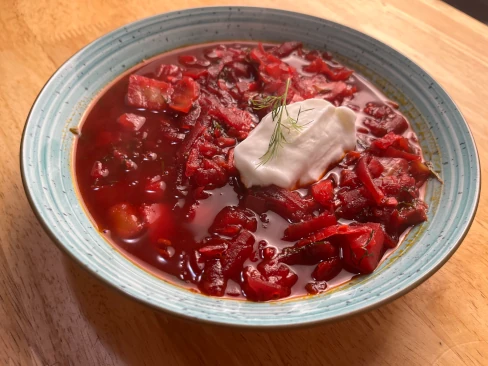The Beet Goes On!
Borscht is a soup commonly found throughout Eastern Europe and Northern Asia with many variations, including cabbage borscht, green borscht, and rye borscht. Growing up in the Canadian Prairies, the variation we’re most familiar with is beet borscht, which happens to be the national dish of Ukraine. Though it traditionally includes bone-in cuts of beef or pork such as ribs or shank, our rendition uses bacon, which we tend to have on hand more often. Borscht is a common meal in our house during the winter months. This is partially because of the comfort and warmth it brings during the cold weather, and also because of its flexibility, which makes it the perfect choice to clean out the fridge. Feel free to use whatever vegetables and meat you have on hand, or even use beans and vegetable stock for a vegetarian rendition.

Getting to the Root of the Matter
Though often attributed to being a root vegetable, beets are actually part stem and part root, and are known for their deep red color. The red is due to a type of plant pigment called Betains, which are also found in Chard, Amaranth, and prickly pears (the fruit of a cactus). Betains come in red and yellow, but only the red Betains contain a phenolic group, which makes them good antioxidants. As well, the red of beets was historically used as a clothing dye, due to its affordability, availability, and effectiveness - anyone who has peeled beets without gloves can attest to the dying power of red beets. The coloring is also not completely metabolized by the human body, and can lead to some "rosy" personal surprises in the following days: Though this can be a startling event, it is in fact harmless.
Beets have been consumed by humans for a long time, though have changed in appearance. Early beets were red or white, and long as opposed to fat: the first record of fat beets were in the 16th century. In the 18th century, sugar beets were cultivated for sugar production, with one fifth of their make up being sucrose. This high sugar content can be useful in desserts and syrups (Red Velvet cake uses beets for it's coloring). Regardless of this sugar content, the nutritional value of beets is solid: they are a great source of folate and a decent source of manganese and potassium.
How to Make It
Prep your beets
Peeling beets can be a difficult and messy business. This method, though longer, requires less hands-on time and makes peeling your beets much easier. Set your oven to 450°F and wash your beets while it heats. Then, trim the roots off your beets andpoke small holes in them with a sharp pairing knife. Cover your beets in a small amount of olive oil and wrap them in foil before baking them until they are tender (50-60 minutes), then set them aside to cool. Once your beets are cool enough to handle, put on gloves and gently rub the beets to remove the skins, which should now come off easily. Once your beets are peeled, use a box grater to grate them then set aside.
Build flavour
In a large pot, cook your bacon on medium-low heat until it is crispy and the fat has rendered out. Remove the cooked bacon from the pot and set it aside, leaving the fat in the pot.



Add your onion, carrot, celery, and potatoes to the pot and sauté until the vegetables begin to soften (about 10 minutes).

Next, add your tomato paste, galic, paprika, thyme, salt, and pepper and cook until fragrant (about 2 minutes).

Simmer and serve
Add your shredded beets and broth to the pot and simmer for 20 minutes, stirring occasionally.



Remove the pot from the heat and add the vinegar and dill, and adjust the salt and pepper to your taste.

Serve in bowls and top with sour cream and more fresh dill. Enjoy!

Beet Borscht
- 4 slices bacon, diced
- 2 lbs beets
- 1 tbs olive oil
- 1 onion, diced
- 2 ribs celery, diced
- 1 large carrot, diced
- 2 cups chopped cabbage
- 1 lb potatoes
- 2 tbs tomato paste
- 1 tsp paprika
- 1/2 tsp dried thyme
- 4 cloves garlic
- 8 cups broth
- 1/2 cup fresh dill
- 2 tbs white vinegar
- Salt and pepper
- Sour cream
- Large pot
- Tinfoil
- Box grater
- Gloves
- Knife
- Paring knife
- Preheat the oven to 450°F.
- Wash your beets, pierce them with a paring knife, cover in olive oil, then wrap in tinfoil.
- Bake the beets until they are tender (50-60 minutes), then set them aside to cool.
- Once your beets are cool enough to handle, peel them and shred them using a box grater and set aside.
- In a large pot on medium-low heat, cook the bacon until the fat has rendered out and it is crispy (about 5 minutes). Remove from the pot and set aside.
- Add the onion, celery, carrot, cabbage, and potatoes to the pot and cook until they begin to soften (about 10 minutes).
- Add the tomato paste, garlic, paprika, thyme, salt and pepper and cook for 2 minutes.
- Add the beets and broth and simmer for 20 minutes.
- Turn off the heat and add the dill and vinegar. Adjust the salt and pepper, then serve with a dollop of sour cream.
